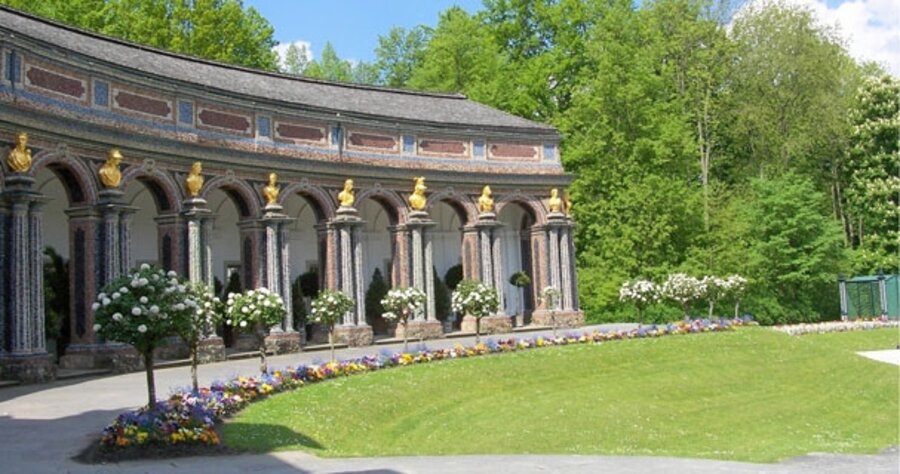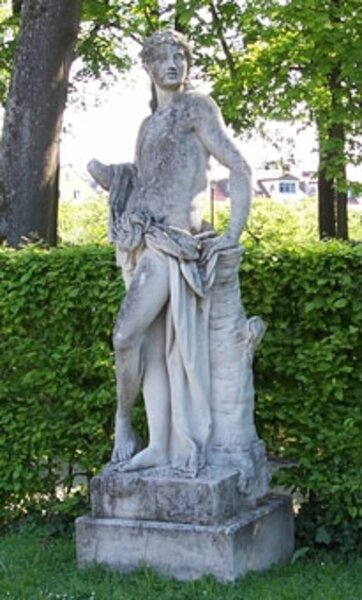German gardens with tales to tell
Loading...
It is to four women that Germany owes some of its finest gardens.
In the 17th century, the Electress Sophie of Hanover turned the pleasure grounds of her husband’s estate in that city into the patterned baroque garden of Herrenhausen.
A century later, Wilhelmine, the sister of Prussia’s Frederick the Great, had the Hofgarten and the Eremitage Palace Gardens fashioned in Bayreuth. Then she, herself, designed the Felsengarten Sanspareil in neighboring Wonsees.
A fourth Bayreuth garden, Park Fantasie, was the work of her daughter Elisabeth Friederike Sophie.
Finally, in the 19th century, the dowry of the Countess Lucie von Pappenheim went to her husband, Prince Hermann Ludwig Heinrich Puckler-Muskau, so he could plant a million trees on their Muskau estate.
I recently visited these elegant German gardens.
Sophie’s gardens
Sophie of Hanover, the mother of the future King George I of England, was born and reared in The Hague, Netherlands, surrounded by the formal baroque gardens there. When she moved to Hanover and became the wife of Duke Ernst August of Brunswick-Luneberg, she was in a position to surround herself with gardens that would remind her of her Dutch childhood.
Work on the famous Grosser Garten (Great Garden) at Herrenhausen, the family summer palace, began in 1679 and continued for 30 years. Sophie moved her palace rooms so that she could better see the work being done in it.
Although more than 90 percent of Hanover – including the elector’s palace – was destroyed in World War II, the 125-acre Great Garden was untouched. Today, in summer, some 30,000 flowers bloom there.
The garden was originally laid out by Marc Charbonnier, whom Sophie had sent to the Netherlands to study Dutch landscape design. Because of the lay of the landscape (it is a flood plain), he surrounded his long rectangular garden with canals on three sides and an avenue of trees on the fourth.
Inside the rectangle are smaller gardens hedged in boxwood and hornbeam. Each of these is in a different shape. Some contain fountains. Some are like checkerboards with potted plants in place of the checkers. One holds an outdoor theater formed by clipped beech trees.
Other special sites in the Great Garden are the Great Cascade of 1676, which bubbles over a bed of shells and stones, and the Great Fountain, which shoots water into the air.
Gardens in the Herrenhausen complex that postdate Sophie are the Georgengarten (George’s Garden) and the Berggarten (Botanical Garden).
The 150-year-old Georgengarten was created in English rather than baroque style. Noteworthy in the garden is an obelisk honoring the Hanover baker Johann Gebhard Helmcke who, in 1805, paid Napoleon’s army a sizable sum if they would not cut down the trees.
The Berggarten, which began as a kitchen garden for the palace, was turned by Sophie into a garden where she grew rare plants. After 1750, it became a botanical garden where many rare plants are still nurtured.
A grove of oaks trees surrounds the royal mausoleum of the Hanover family. Sophie, Duke Ernst August, and their son, George, are buried there.
Wilhelmine’s gardens
The first gardens that the Margravine Wilhelmine had designed in Bayreuth were at the Eremitage (Hermitage), which her husband, Friedrich, gave her after their marriage. She set to work in 1736 and had the formal baroque garden transformed into a more tranquil landscaped park.
The Eremitage’s Neues Schloss (New Palace) was largely destroyed during World War II, and today only a facade remains. But the gardens below it have been restored with flower-bordered pathways in 18th-century style.
In 1753, Wilhelmine turned her attention to the construction of a new castle set in the 33-acre Hofgarten. A tree-shaded canal with flower-covered islands in it was the centerpiece of the park she had designed.
After her death, the garden was altered to the freer English style with many tree-shaded paths. The centerpiece, however, remains the gentle, riverlike canal.
Also outside Bayreuth is Wilhelmine’s third garden, Felsengarten Sanspareil (Rock Garden Without Equal). It lies below the medieval Fortress Zwernitz, where she admired the great rock formations.
She imagined the rocks and caves as places in the mythical life of Telemachus, the son of Ulysses. So she gave the formations names, such as Calypso and Mentor Grotto, which were important in his story.
Schloss Fantasie
Wilhelmine and Friedrich had one child, Elisabeth Friederike Sophie, and after Wilhelmine’s death, Friedrich began building a palace for her in Dorndorf, outside Bayreuth.
There she had baroque gardens designed and an enormous Neptune fountain with a waterfall constructed. Ornate stone benches with animal heads carved into them remain, and hedges like those of her day have been replanted.
Today the Fantastic Palace is the site of Germany’s first Museum of Garden Art.
Schlosspark Muskau and Branitz
Schlosspark Muskau in Bad Muskau, south of Cottbus, is a park garden of rivers, streams, and trees that wouldn’t have been created without the financial aid of Lucie von Pappenheim.
In 1817, the wealthy Prussian divorcée became the wife of the virtually penniless Prince Hermann Ludwig Heinrich Puckler-Muskau. Both shared a devotion to gardens.
Her dowry promptly went into extravagant tree-planting on his inherited land. The prince’s aim was to blend nature and art, landscape and buildings into a perfect ensemble.
It wasn’t long before the money began to run out. So the prince suggested to Lucie that she give him up. He would go to England, find an heiress to marry, and bring her back to Germany to finance the garden.
Lucie acquiesced, and in 1826 Puckler went heiress-hunting. He charmed woman after woman, but none enough to marry him. He did, however, learn even more about English landscaping. And, although he courted English ladies, Puckler continued to write back lovingly to Lucie, his “Lambkin.”
She kept all of his letters and, on his return, had them published. They were highly acclaimed, with Goethe putting them “in the highest class of literature.” (A later book, Puckler’s “Hints on Landscape Gardening” inspired the creation of many American and European parks.)
The money from the publication of Puckler’s letters substituted – for a while – for what an English heiress might have brought to Muskau. But in the end, he was forced to sell the estate and move to neighboring Branitz.
Puckler transformed Branitz from wasteland into a park of hills and rambling walks. He set statues in the meadows and had two earthen pyramids constructed. In one of these, he and Lucie are buried.






